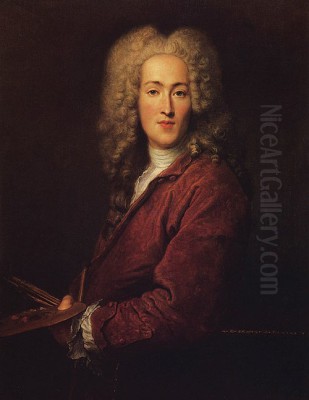
Nicolas Lancret stands as a significant figure in the glittering world of eighteenth-century French art. Born in Paris in 1690 and passing away in the same city in 1743, his life spanned a period of profound cultural and artistic transformation. He emerged as a leading painter during the Rococo era, a style characterized by lightness, elegance, and an emphasis on the pleasures of aristocratic life. Lancret specialized in the fête galante, or "courtship party," a genre depicting idyllic outdoor gatherings filled with finely dressed figures engaged in conversation, music, and flirtation. Though often seen in the shadow of his contemporary, Antoine Watteau, Lancret developed a distinct and highly popular style that captured the spirit of his age with charm and precision.
Parisian Roots and Early Artistic Formation
Nicolas Lancret's journey into the art world began in Paris, the vibrant heart of French culture. Born into a family with artisanal roots – his father was a craftsman – Lancret initially pursued training in engraving. This early grounding in line and form likely contributed to the clarity found in his later paintings. However, his aspirations soon turned towards painting. He first became an apprentice to Pierre Dulin, a history painter working in the more traditional, grand manner favored by the French Royal Academy of Painting and Sculpture (Académie Royale de Peinture et de Sculpture).
This initial training under Dulin exposed Lancret to the academic hierarchy, which placed history painting at its apex. However, Lancret's temperament and talents perhaps leaned elsewhere. A pivotal shift occurred when he entered the studio of Claude Gillot. Gillot was a fascinating artist in his own right, known for his lively scenes inspired by the Italian Commedia dell'arte and contemporary theatre. Crucially, Gillot had also been the master of Antoine Watteau, the very artist who would become most associated with the fête galante and exert a profound influence on Lancret himself.
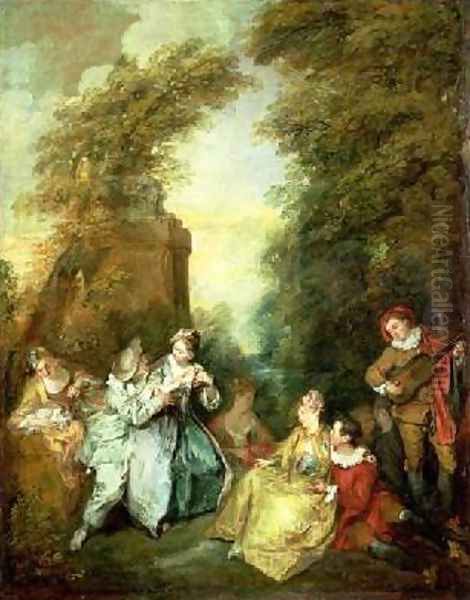
Lancret formally enrolled in the Royal Academy in 1708, hoping to follow the conventional path to success by winning the prestigious Prix de Rome competition in history painting. His failure in this competition proved to be a turning point. Rather than becoming discouraged, Lancret seems to have recognized that his strengths lay not in the grand narratives of history and mythology, but in the observation and depiction of contemporary life and manners. This realization, likely encouraged by his time with Gillot and his growing awareness of Watteau's work, set him on the path that would define his career.
The Influence of Watteau and the Rise of the Fête Galante
The influence of Antoine Watteau on Nicolas Lancret cannot be overstated. Watteau, though his career was tragically short (he died in 1721), had revolutionized French painting with his fêtes galantes. These works, such as his famous Pilgrimage to Cythera, blended landscape and figurative painting with a unique sense of poetry, gentle melancholy, and theatricality. They captured the refined leisure and subtle emotional currents of aristocratic society in a way that was entirely new.
Lancret deeply admired Watteau's approach. Early biographical accounts suggest that Watteau himself offered advice to the younger artist, encouraging him to abandon the pursuit of history painting and instead to sketch directly from nature and focus on scenes reflecting the charm and humour of everyday life. Lancret absorbed these lessons, adopting the fête galante theme and Watteau's emphasis on elegant figures in parkland settings.
However, Lancret was no mere copyist. While Watteau's works often possess an underlying wistfulness, a sense of the transience of pleasure, Lancret's interpretations tend to be more straightforwardly cheerful and anecdotal. His figures are often more robust, his narratives clearer, and his colours perhaps brighter and more declarative than the subtle, shimmering tones frequently employed by Watteau. He took the framework established by Watteau and infused it with his own distinct personality and observational skills.
Academic Recognition and Growing Reputation
Despite his earlier setback in the history painting competition, Lancret's talent in depicting "modern subjects" did not go unnoticed. In 1717 or, more definitively, by 1719, he was formally received (agréé) and then accepted as a full member (reçu) of the Royal Academy. Significantly, he was admitted specifically as a peintre de fêtes galantes, a category seemingly created for Watteau and now extended to his talented follower. His reception piece, likely a work titled Conversation Galante, demonstrated his mastery of the genre and secured his official standing within the art establishment.
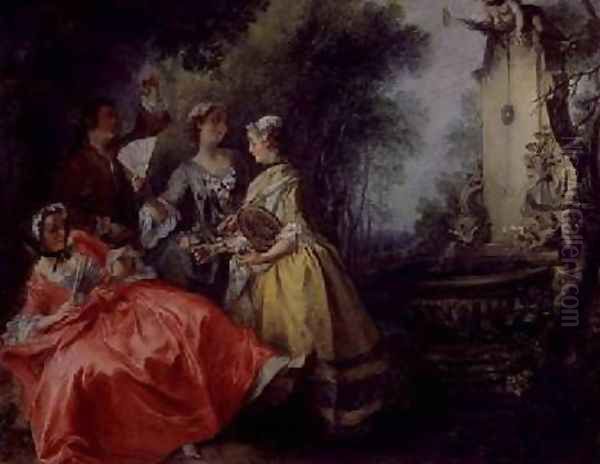
His admission to the Academy marked the beginning of a highly successful and prolific career. Lancret quickly found favour with patrons and collectors who appreciated his charming depictions of contemporary aristocratic life. His style, less ambiguous and perhaps more accessible than Watteau's, resonated with the tastes of the Regency and the early reign of Louis XV. He became a sought-after painter, his works adorning the hôtels particuliers of Paris and the châteaux of the French nobility.
Lancret's reputation grew steadily throughout the 1720s and 1730s. He exhibited regularly at the Paris Salon, the official exhibition of the Academy, allowing his work to be seen by a wider public. His success was built on a combination of artistic skill, an astute understanding of his patrons' desires, and a remarkable work ethic.
The Signature Style of Nicolas Lancret
Lancret's art is defined by its elegance, vivacity, and keen observation. He excelled at capturing the grace and deportment of the French aristocracy, paying meticulous attention to the details of fashion, gesture, and social interaction. His compositions are typically well-structured, often featuring groups of figures arranged harmoniously within landscape or interior settings. While influenced by Watteau's fluid arrangements, Lancret's groupings can sometimes feel more deliberately staged, allowing the narrative elements to come to the fore.
Colour plays a crucial role in Lancret's paintings. He employed a bright and appealing palette, often favouring clear blues, pinks, yellows, and greens. His handling of paint is generally smooth and refined, though often with lively brushwork evident in the rendering of foliage or fabrics. Compared to the sometimes ethereal quality of Watteau, Lancret's world feels more tangible and grounded, his figures possessing a clearer physical presence. He captured the textures of silk, satin, and lace with considerable skill, contributing to the overall sense of luxury and refinement.
A defining characteristic of Lancret's work is its narrative clarity. While Watteau often evokes a mood or atmosphere, Lancret frequently depicts specific activities or social rituals: dances, concerts, games, meals, flirtatious encounters. There is often a gentle humour or light-heartedness to his scenes, a celebration of the carefree pleasures of elite society. He observed the nuances of social etiquette and romantic interplay with a sharp eye, translating them into charming visual anecdotes.
Themes of Leisure and Sociability
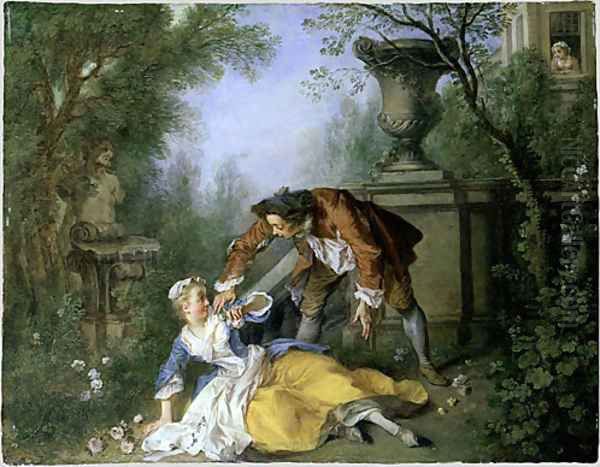
The fête galante remained the cornerstone of Lancret's output throughout his career. He painted numerous variations on this theme, depicting elegant companies enjoying themselves in lush gardens, often near fountains or classical statues. Music-making, dancing (particularly the popular minuet), conversation, and games like blind man's buff or shuttlecock are recurring motifs. These scenes presented an idealized vision of aristocratic leisure, emphasizing harmony, refinement, and romantic possibility.
Beyond the classic fête galante, Lancret explored related themes. He was drawn to the world of the theatre, like his master Gillot and Watteau before him. He painted scenes inspired by popular plays and the characters of the Commedia dell'arte, capturing their theatricality and humour. These works often show a slightly more robust and less idealized approach than his parkland scenes.
Lancret also depicted scenes of domestic life, showing interiors where figures engage in activities like taking tea, playing cards, or reading letters. These paintings offer glimpses into the private world of the eighteenth-century elite. Furthermore, he undertook several series of paintings based on allegorical themes, often related to the passage of time or the stages of life. These include popular sets depicting The Four Seasons, The Four Times of Day, and The Four Ages of Man, allowing him to explore different activities and moods associated with each concept.
Representative Masterpieces
Among Lancret's extensive body of work, several paintings stand out as particularly representative of his style and themes. The Birdcage (Le Vogelkäfig), housed in the Wallace Collection, London, is a quintessential example of his charm. It depicts a young man presenting a birdcage to a seated young woman in a garden setting, a simple act imbued with gentle romantic suggestion. The figures are elegantly posed, the costumes rendered with care, and the surrounding landscape provides an idyllic backdrop.
His series The Four Times of Day (versions exist in the National Gallery, London, and elsewhere) showcases his ability to vary mood and activity within a thematic framework. Morning might depict a lady at her toilette, Midday an outdoor picnic or repose, Afternoon a sociable gathering for music or games, and Evening an indoor concert or supper. Each scene is meticulously detailed, capturing the specific atmosphere and social customs associated with that part of the day.
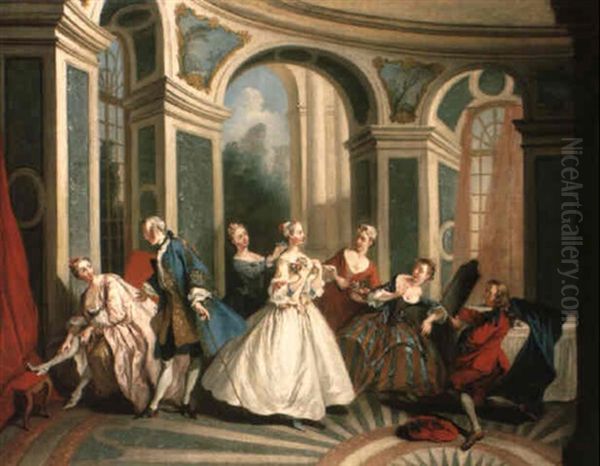
Works like Dance in a Garden or Dance Before a Fountain exemplify his skill in depicting movement and social interaction. These paintings often feature multiple couples engaged in elegant dances like the minuet, their coordinated movements creating a sense of rhythm and grace within the composition. Lancret captures the flowing lines of the dancers' bodies and costumes, set against verdant parklands. Another notable work, The Servant Justified, demonstrates his ability to handle more anecdotal, slightly humorous narratives drawn from contemporary life or literature.
Esteemed Patrons and Academic Standing
Lancret's appealing style earned him considerable success and prestigious patronage. His works were highly sought after by the French aristocracy and wealthy financiers. Notably, he received commissions from King Louis XV himself, painting scenes for the royal residences, including the Château de La Muette and apartments at Versailles. This royal favour significantly enhanced his status and desirability among other collectors.
His reputation extended beyond France. Frederick the Great of Prussia was a great admirer and acquired a significant number of Lancret's paintings for his palaces, particularly Sanssouci in Potsdam. These works played a role in disseminating the French Rococo style in German courts. Lancret's paintings were also popular among English collectors visiting Paris on the Grand Tour.
Within the art world, Lancret maintained a respected position. He continued to exhibit at the Salon and actively participated in the life of the Royal Academy. His success and experience were recognized in 1735 when he was appointed as a councilor (conseiller) to the Academy, a position reflecting his seniority and esteem among his peers. This role involved him in the administrative and teaching functions of the institution that had initially been hesitant to fully embrace his chosen genre.
Lancret in the Context of His Contemporaries
Lancret worked during a rich period for French painting, interacting with and responding to a number of talented contemporaries. His relationship with Antoine Watteau was foundational, establishing the genre in which he primarily worked. He is often discussed alongside Jean-Baptiste Pater, another painter who closely followed Watteau's style of fête galante. While Pater's work can sometimes be confused with Lancret's, Pater often displays a slightly softer touch and perhaps less narrative focus. They were colleagues, sometimes seen as friendly rivals, catering to the same market demand for Watteau-esque scenes after the master's death.
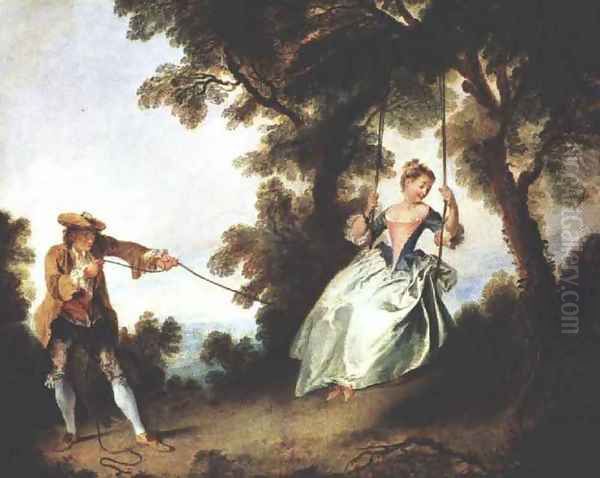
François Boucher, another giant of the Rococo, was a younger contemporary whose career overlapped significantly with Lancret's later years. While Boucher also depicted scenes of leisure and mythology with elegance and charm, his style developed towards a more overtly decorative and sensual manner, often featuring more voluptuous figures and a lighter, more pastel-dominated palette. Both artists, however, shared influences from Watteau and contributed significantly to the visual culture of Louis XV's reign. They both received royal commissions and even worked on designs for the Beauvais tapestry manufactory, indicating their parallel prominence.
Other notable artists of the period include the portraitists Hyacinthe Rigaud and Nicolas de Largillière, who captured the likenesses of the same elite society Lancret depicted in genre scenes. Jean-Marc Nattier specialized in elegant, often mythologized portraits of court ladies. Charles-Joseph Natoire was a competitor in decorative painting schemes, while Jean-Honoré Fragonard would later emerge as the final great master of the Rococo fête galante, pushing its exuberance and painterly freedom even further, clearly indebted to the foundations laid by Watteau, Lancret, and Boucher. In contrast, the quiet realism of Jean-Baptiste-Siméon Chardin offered a very different view of eighteenth-century life, focusing on bourgeois domesticity rather than aristocratic leisure. Lancret's work sits firmly within the mainstream Rococo taste for elegance, pleasure, and refined sociability.
Glimpses into the Artist's Life and Character
While historical records primarily focus on his artistic output, some details offer glimpses into Nicolas Lancret's personality and life beyond the studio. Accounts suggest he was a man of deep religious conviction, a trait perhaps reflected in the general propriety and lack of overt licentiousness in his works compared to some other Rococo artists. His piety was reportedly coupled with a practical approach to his work; anecdotes mention his need to eat frequently while painting, suggesting intense concentration and physical engagement with his craft.
Lancret remained unmarried until relatively late in life. In 1740, at the age of 50, he married Marie Boursault, the widow of a bookseller, who was significantly younger than him. This late marriage seems to have been a happy one. Upon his death just three years later, he left his entire estate to his wife, indicating his affection and sense of responsibility towards her.
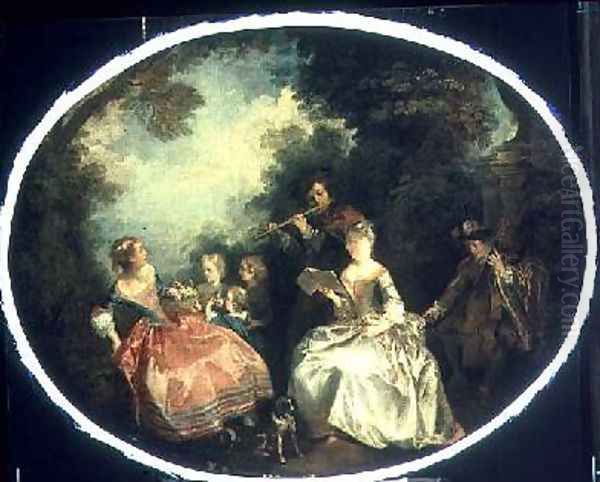
His prolific output – some sources claim he produced around 700 paintings, particularly during the 1720s – attests to his diligence and the high demand for his work. He was also known for his kindness and patience, particularly towards younger artists seeking guidance, earning him a reputation as an approachable and respected figure in the Parisian art community. Beyond painting, Lancret was also a collector, amassing a considerable number of drawings and prints, reflecting his deep engagement with the broader art world.
A poignant detail concerns his later health. Some biographical sources suggest that Lancret suffered from failing eyesight towards the end of his life, possibly linked to the pigments he used, perhaps including toxic red lead. Despite this potential hardship, he seems to have continued working. An inventory taken after his death reportedly listed an unfinished painting of doves, suggesting his artistic endeavours continued until the very end.
Final Years and Passing
Nicolas Lancret's successful career continued into the early 1740s. He remained active within the Academy and continued to receive commissions. However, his life was cut short. He died in Paris on September 14, 1743, at the age of 53. His relatively early death, like Watteau's, removed a major figure from the French art scene. He left behind a substantial body of work and a well-established reputation. His widow, Marie Boursault, oversaw the posthumous sale of his studio contents and collection.
Legacy and Influence
Following his death, Lancret's reputation experienced a period of relative decline, particularly as artistic tastes shifted towards Neoclassicism later in the eighteenth century. The light-hearted elegance of the Rococo fell out of favour. However, his work was never entirely forgotten, and he experienced a significant revival of interest during the nineteenth century, particularly with the renewed appreciation for Rococo art championed by figures like the Goncourt brothers.
Today, Nicolas Lancret is recognized as a key figure in eighteenth-century French painting. While inevitably compared to Watteau, he is valued for his own distinct contributions. He successfully adapted the fête galante genre, making it highly popular and accessible, and provided invaluable visual documentation of the social customs, fashion, and leisure activities of the French aristocracy during the Regency and the reign of Louis XV. His clear narratives and charming depictions of sociability offer a fascinating window into that world.

His influence extended to other artists. François Boucher certainly absorbed elements from Lancret's approach to genre scenes. Across the English Channel, the narrative and satirical genre scenes of William Hogarth, while possessing a very different moralizing intent, share an interest in depicting contemporary manners and social interactions that finds parallels in Lancret's work, albeit viewed through a different cultural lens. Lancret's paintings, widely disseminated through engravings, helped to spread the Rococo style and its characteristic themes throughout Europe.
Conclusion: Capturing Rococo Charm
Nicolas Lancret's art embodies the grace, charm, and refined pleasures of the French Rococo. As a master of the fête galante, he captured the ephemeral world of aristocratic leisure with elegance and precision. Building on the innovations of Watteau, he developed his own distinct voice, characterized by clear narratives, vibrant colours, and meticulous observation of social life. His paintings offer more than just decorative appeal; they are valuable historical documents, chronicling the fashions, manners, and pastimes of a specific era. Though perhaps lacking the profound poetry of Watteau or the exuberant sensuality of Boucher, Lancret's work possesses a unique and enduring charm, securing his place as a significant and highly appealing painter of the eighteenth century.